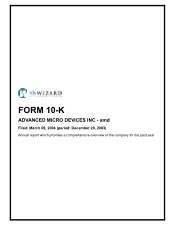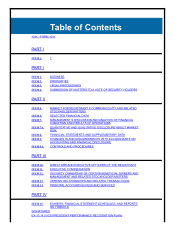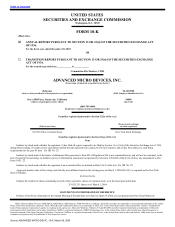AMD 2003 Annual Report Download - page 8
Download and view the complete annual report
Please find page 8 of the 2003 AMD annual report below. You can navigate through the pages in the report by either clicking on the pages listed below, or by using the keyword search tool below to find specific information within the annual report.
Table of Contents
For financial information about geographic areas and for segment information with respect to sales and operating results, refer to the information set forth
in Note 9 of our consolidated financial statements on page 83, below.
For a discussion of the risk factors related to our business operations, please see the sections entitled, “Cautionary Statement Regarding Forward-Looking
Statements,” above, and the “Risk Factors” and “Financial Condition” sections set forth in “Management’s Discussion and Analysis of Financial Condition and
Results of Operations,” beginning on page 20, below.
The Integrated Circuit Market
The integrated circuit market has grown dramatically over the past two decades, driven primarily by the demand for electronic business and consumer
products. Today, virtually all electronic products use integrated circuits, including PCs and related peripherals, wired and wireless voice and data
communications and networking products, including cellular phones, facsimile and photocopy machines, printers, home entertainment equipment, industrial
control equipment and automobiles.
The market for integrated circuits can be divided into separate markets for digital and analog devices. We participate in the market for digital integrated
circuits. The three types of digital integrated circuits used in most electronic systems are:
• microprocessors, which are used for control and computing tasks, and complementary chipset devices, which perform essential logic functions that
support the microprocessors;
• memory circuits, which are used to store data and programming instructions; and
• logic circuits, which are employed to manage the interchange and manipulation of digital signals.
Within the digital integrated circuit market, we participate primarily in the microprocessor and Flash memory markets. In addition, we participate in the
embedded processor market for personal connectivity devices.
Computation Products
The Microprocessor Market
A microprocessor is a silicon integrated circuit that serves as the central processing unit, or CPU, of a computer. It generally consists of millions of
transistors that process data and control other devices in the system, acting as the brain of the computer. The performance of a microprocessor is typically a
critical factor impacting the performance of a PC and other similar devices. The indicators of microprocessor performance are work-per-cycle, or how many
instructions are executed per cycle, and clock speed, representing the rate at which its internal logic operates, measured in units of hertz, or cycles processed per
second. Other factors of microprocessor performance include the amount of memory storage and the speed at which data stored in memory can be accessed.
Developments in circuit design and manufacturing process technologies have resulted in dramatic advances in microprocessor performance over the past two
decades. With the introduction of our AMD Athlon XP processor in October 2001, we began positioning our processors based on overall performance, which is a
function of both architecture and clock speed. We believe overall performance is a better indicator of CPU capability than simply clock speed.
Improvements in the performance characteristics of microprocessors and decreases in production costs resulting from advances in manufacturing process
technology as well as a corresponding decrease in selling prices have increased the demand for microprocessors over time. The greatest demand for
microprocessors today is from PC manufacturers. With few exceptions, these manufacturers require x86 microprocessors that are compatible with the Microsoft®
Windows® operating system.
3
Source: ADVANCED MICRO DEVIC, 10-K, March 09, 2004





















